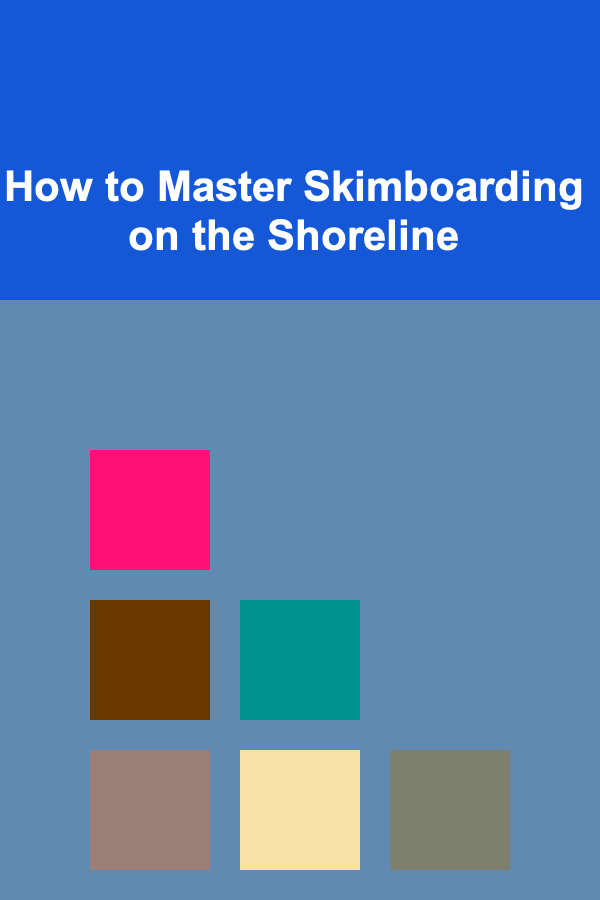
How to Master Skimboarding on the Shoreline
ebook include PDF & Audio bundle (Micro Guide)
$12.99$10.99
Limited Time Offer! Order within the next:

Skimboarding is an exhilarating sport that blends elements of surfing and skateboarding, offering thrill-seekers a unique way to experience the shoreline. Unlike traditional surfing, which relies on large waves, skimboarding involves gliding across the shallow water along the edge of the beach, often performed on small waves or flat water. Mastering skimboarding can be a challenging yet rewarding experience that requires dedication, balance, and an understanding of the dynamics of the ocean.
This comprehensive guide will walk you through the essential steps and techniques to master skimboarding on the shoreline. Whether you are a beginner looking to learn the basics or an intermediate rider aiming to refine your skills, this article provides valuable insights into every aspect of the sport.
Understanding the Basics of Skimboarding
Before diving into the advanced techniques, it's important to understand the core elements of skimboarding. Skimboarding is typically performed on a beach where the water is shallow, and waves are either coming in or receding. The objective is to ride the skimboard on the thin layer of water, often gliding across the wet sand or catching small waves near the shore.
The Skimboard
A skimboard is different from a surfboard in several key aspects:
- Size: Skimboards are typically smaller and lighter than surfboards, with a width ranging from 18 to 22 inches and a length of 44 to 50 inches.
- Shape: The shape of the skimboard is more compact, with a flat or slightly curved bottom to allow it to glide easily over the water's surface.
- Material: Skimboards are generally made from materials such as wood, fiberglass, or carbon fiber. Wood boards are common for beginners, while fiberglass and carbon fiber offer better performance for advanced riders.
The Conditions
Skimboarding can be performed on both flat water and small waves. However, understanding the conditions of the shoreline is essential for mastering the sport. There are three primary types of conditions that affect skimboarding:
- Flat Water: This is the easiest and most beginner-friendly condition, where the water is calm, and you can glide across the wet sand without the need for waves.
- Shore Break: When waves crash near the shoreline, this creates a small, breaking wave that is ideal for riders looking to catch a wave and ride back to shore.
- Wave Skimboarding: For more advanced riders, catching a wave and riding it back to shore is the ultimate challenge. This requires timing, skill, and understanding of wave dynamics.
Essential Skimboarding Techniques
Skimboarding requires a range of skills, from balance to timing. Let's break down the key techniques to master the sport effectively.
1. Learning to Ride
The first step in mastering skimboarding is learning how to ride the board across the shoreline. This technique will allow you to get comfortable with the motion of the board and the feeling of gliding across the water.
Stance and Balance
The stance on a skimboard is similar to skateboarding or surfing. Here's how to position yourself:
- Feet Position: Place your feet shoulder-width apart on the board, with your front foot slightly ahead of the center and your back foot towards the tail of the board.
- Knees: Keep your knees slightly bent to maintain balance and flexibility.
- Body Posture: Keep your body slightly leaned forward with your arms out to help you maintain stability. Your head should be looking forward, and your core engaged to keep your balance.
Running and Throwing the Skimboard
The most common way to initiate your ride is by running towards the water and throwing your skimboard down to the wet sand or shallow water.
- The Run: Start by jogging towards the water at a moderate pace. As you approach the shoreline, begin to increase your speed.
- Throwing the Board: As you reach the wet sand, drop the board down in front of you and hop onto it. You'll want to throw the board at a slight angle into the water so that it can glide smoothly.
2. Catching Waves
Catching waves is a significant skill that requires precise timing and control. When you successfully ride a wave, it creates an entirely different experience compared to gliding over flat water.
Timing the Wave
To catch a wave, wait until the water is receding, then sprint towards the shoreline, aiming to meet the oncoming wave. As the wave starts to approach, quickly hop onto the skimboard and glide across the shallow water, trying to maintain your balance as you follow the natural motion of the wave. It's important to time your run so that you meet the wave at the right moment and don't miss the opportunity to ride it.
Riding the Wave
Once you're on the wave, shift your weight slightly to the back foot to maintain speed. You can adjust your speed by leaning forward or backward, but be careful not to overbalance or lose control of the board. Keep your eyes on the wave and adjust your body position accordingly.
3. Turning and Carving
Once you have the basics of riding and catching waves, you can start refining your skills by learning to turn and carve on the water. Turning and carving give you more control over the board, allowing you to maneuver around obstacles and ride waves more smoothly.
Turning
To make a basic turn, shift your weight toward your back foot and gently lean to the side you want to turn. This will create enough pressure on the edge of the board to pivot it in the desired direction.
Carving
Carving involves making smoother, more controlled turns by shifting your weight from one foot to the other, similar to snowboarding or surfing. Carving is about rhythm and flow, and once mastered, it will allow you to ride waves with more finesse and style.
4. Jumping and Tricks
Once you feel confident on the water, you can try incorporating jumps and other tricks into your skimboarding repertoire. These tricks add a fun and exciting element to the sport and allow you to show off your skills.
The Basic Jump
The basic jump involves pushing down on the tail of the board and popping it into the air while you remain in the air. This requires a combination of speed and balance, as you must push off the water at the right moment to lift the board.
Advanced Tricks
As you progress, you can try more complex tricks, such as spins, flips, and slides. These tricks require quick reflexes, balance, and advanced control over the skimboard. Some advanced tricks include:
- 180 and 360 Spins: Rotate the board while jumping to spin it in the air.
- Shuvits: A shuvit involves spinning the board 180 degrees beneath you while you remain stationary.
- Wave Rides: Riding small waves while performing tricks adds another layer of challenge to your skimboarding experience.
Mastering Skimboarding Through Practice
As with any sport, the key to mastering skimboarding is consistent practice. Here are a few tips to help you progress:
1. Start Slow and Progress Gradually
Don't rush your learning. Start by mastering the basics, such as getting on the board and riding in a straight line, before moving on to advanced tricks or wave riding. Practice in different conditions to get used to the challenges each offers.
2. Focus on Your Stance and Balance
Proper stance and balance are essential for controlling the board. Spend time working on your balance both on and off the water, as this will translate to better control when you're on the skimboard.
3. Study the Waves
Spend time observing the waves and understanding their patterns. The better you understand how the waves break, the more efficiently you can catch them. This skill comes with experience, so be patient and stay alert.
4. Watch Others and Learn
If possible, observe skilled skimboarders at the beach. Watching others will give you a sense of timing, techniques, and styles that you can incorporate into your own riding. Don't be afraid to ask for advice from experienced riders---they can offer valuable tips.
5. Take Care of Your Equipment
Maintaining your skimboard is important for optimal performance. Keep it clean, check for any cracks or damages, and replace any parts that wear out over time. A well-maintained board will give you better control and more enjoyable rides.
Conclusion
Skimboarding on the shoreline is a thrilling and rewarding sport that offers endless opportunities for fun and personal growth. By mastering the basic techniques, understanding the conditions, and progressing through more advanced skills, you can become an expert in this exciting sport. With practice and patience, you'll be able to glide across the water, catch waves, perform tricks, and enjoy the beauty of the shoreline from a unique perspective. Whether you're a beginner or an experienced rider, the key to mastering skimboarding is a commitment to learning and improvement.

Best Organization Tools for Writers and Creatives
Read More
Effective Strategies for Call Center Representatives: Enhancing Communication and Satisfaction
Read More
How To Develop a Strong Willpower Muscle
Read More
How to Implement a Digital Note-Taking System that Works for You
Read More
How to Plan a Successful Potluck Party at Home
Read More
How to Use Vertical Space for Bedroom Organization
Read MoreOther Products

Best Organization Tools for Writers and Creatives
Read More
Effective Strategies for Call Center Representatives: Enhancing Communication and Satisfaction
Read More
How To Develop a Strong Willpower Muscle
Read More
How to Implement a Digital Note-Taking System that Works for You
Read More
How to Plan a Successful Potluck Party at Home
Read More